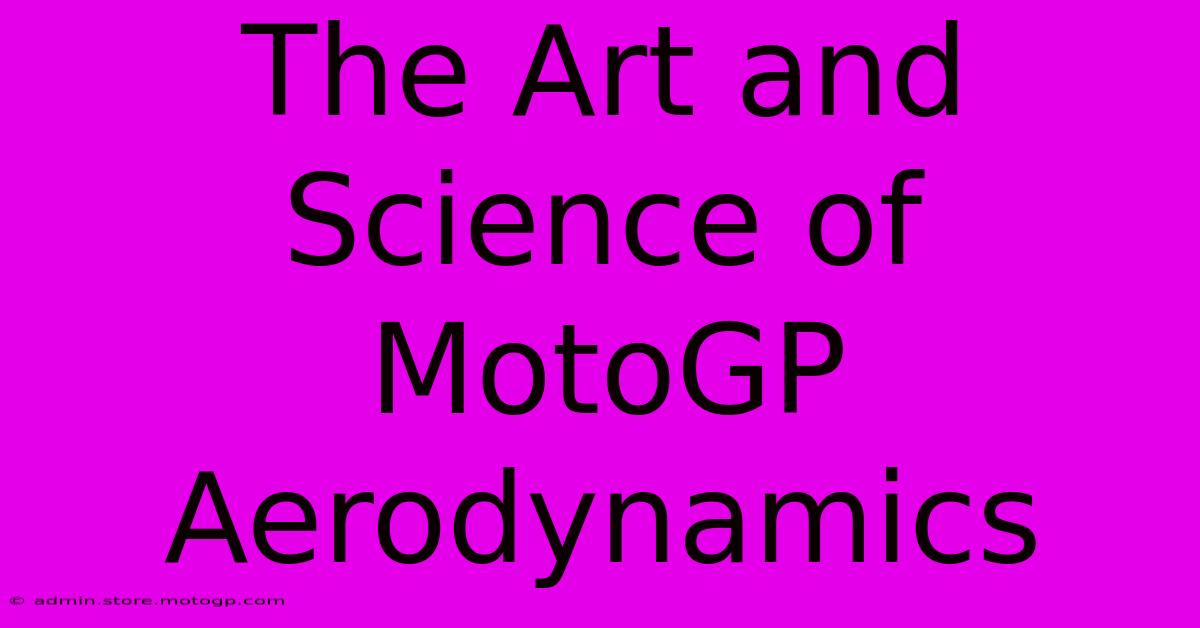The Art And Science Of MotoGP Aerodynamics

Table of Contents
The Art and Science of MotoGP Aerodynamics
MotoGP, the pinnacle of motorcycle racing, is a relentless pursuit of speed and performance. While rider skill and engine power are crucial, a often-overlooked factor significantly impacting race results is aerodynamics. This article delves into the fascinating interplay of art and science that shapes MotoGP bike aerodynamics, exploring its evolution, current applications, and future possibilities.
Understanding the Aerodynamic Challenge
MotoGP bikes operate at incredibly high speeds, generating substantial aerodynamic forces. These forces, primarily drag and downforce, significantly affect performance. Drag resists forward motion, reducing top speed and acceleration. Downforce, on the other hand, pushes the bike towards the track, enhancing stability and cornering grip at high speeds. The challenge for engineers is to minimize drag while maximizing downforce – a delicate balancing act.
The Importance of Downforce
At speeds exceeding 200 mph, downforce is critical for maintaining control. It prevents wheel lift at high speeds, improves traction through corners, and allows riders to brake later and harder, shaving crucial milliseconds off lap times. Insufficient downforce leads to instability, making the bike difficult to control and increasing the risk of crashes.
The Evolution of MotoGP Aerodynamics
The evolution of MotoGP aerodynamics reflects continuous innovation and a constant push for marginal gains.
Early Days: Minimal Aerodynamic Aids
Early MotoGP bikes featured relatively simple bodywork with minimal aerodynamic considerations. The focus was primarily on engine performance and chassis design.
The Rise of Winglets and Fairings
The introduction of winglets and sophisticated fairings marked a turning point. These aerodynamic devices, initially small and subtle, gradually became larger and more complex, generating significant downforce.
Sophisticated CFD and Wind Tunnel Testing
Modern MotoGP aerodynamic development relies heavily on Computational Fluid Dynamics (CFD) simulations and extensive wind tunnel testing. These tools allow engineers to refine designs with incredible precision, optimizing airflow around the bike and rider.
Current Aerodynamic Solutions in MotoGP
Modern MotoGP bikes showcase a breathtaking level of aerodynamic sophistication:
Advanced Fairings and Bodywork
Fairings are sculpted to manage airflow, directing it strategically to minimize drag and maximize downforce. Every curve, angle, and surface is carefully designed to optimize performance.
Winglets and Aero Devices
Winglets, strategically placed on the fairing and sometimes on the swingarm, generate downforce by manipulating airflow. These devices are constantly being refined and improved, reflecting the ongoing quest for performance enhancement.
Rider Position and Aerodynamic Drag
Even the rider's position plays a vital role in aerodynamics. Tucking down reduces drag and improves stability. This is why riders adopt a low, aerodynamic posture during high-speed sections.
The Future of MotoGP Aerodynamics
The pursuit of aerodynamic excellence in MotoGP is far from over. We can expect continued advancements in several areas:
Active Aerodynamics
Active aerodynamic systems, which adjust the aerodynamic configuration of the bike in real-time based on speed and conditions, hold immense potential. This could allow for optimal downforce and drag reduction across varying track sections.
Biomimicry in MotoGP Design
Inspired by nature's aerodynamic designs, biomimicry could further enhance aerodynamic efficiency. Studying the streamlined shapes of birds and marine animals might lead to innovative bodywork designs.
Material Science Advancements
New lightweight and high-strength materials could enable the development of even more sophisticated aerodynamic components. This could reduce weight while maintaining or improving aerodynamic performance.
Conclusion: A Constant Evolution
The art and science of MotoGP aerodynamics is a dynamic field marked by constant innovation and the relentless pursuit of marginal gains. The advancements in this area are not just about speed; they are fundamental to rider safety and race performance. As technology continues to evolve, we can anticipate even more impressive advancements in the quest for ultimate aerodynamic efficiency in the future of MotoGP.

Thank you for visiting our website wich cover about The Art And Science Of MotoGP Aerodynamics. We hope the information provided has been useful to you. Feel free to contact us if you have any questions or need further assistance. See you next time and dont miss to bookmark.
Featured Posts
-
Cota Qualifying F1s Grid Positions Decided
Feb 18, 2025
-
Circuit Race Safety Stay Safe On The Track
Feb 18, 2025
-
Austin Gp Concert Experience The Thrill Of A Lifetime
Feb 18, 2025
-
Troubleshooting Your V 4 Yamaha
Feb 18, 2025
-
Explore The World With A Yamaha V4 Engine
Feb 18, 2025
